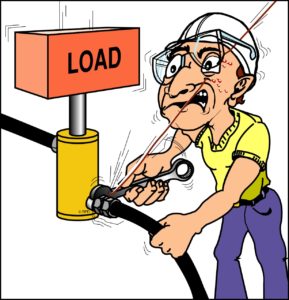The Penalty of Making an Incorrect Assumption
A mill maintenance technician who had some hydraulic training was badly injured in an accident at a sawmill. He was trying to remove a hydraulic cylinder from a production machine so he could replace the rod seal, which was leaking. The cylinder was mounted vertically, and its piston rod was supporting a relatively heavy structure.
The technician began by powering up the hydraulic system and retracting the cylinder to lower the load. He figured this would relieve any pressure in the hose running from the cap end of the cylinder to a valve manifold about 75 ft away.
When he loosened the hose-end connector to remove the hose from the cap end of the cylinder, a stream of oil unexpectedly discharged from the connector at high velocity. The jet of oil struck him in the face, penetrated his cheek, and spilled into his mouth. He said he could taste hydraulic oil in his mouth for three days after the accident. This was because the toxic oil injected into his cheek slowly leaked from the pinhole-sized wound.
Prior to the accident, the technician had been told that the hose cylinder circuit contained a counterbalance valve to prevent the load from dropping if the hose underwent a catastrophic failure or came loose. Therefore, he assumed there would be little or no pressure in the line with no power to the machine.
However, he did not know that the counterbalance valve had been installed in a valve manifold downstream from where he was working. Therefore, pressurized fluid could become trapped in the hose between the counterbalance valve and the cylinder port.
Even if the counterbalance valve had been installed at the cap-end port of the cylinder instead of the manifold, there’s still no guarantee that the hose carried no pressure. The counterbalance valve in the cylinder would’ve kept the load from dropping when the technician removed the hose, but it would not relieve any pressure trapped in the hose. Regardless, the technician should have positively determined if there was any pressure in the hose before he began working on it.
The victim was surprised that the oil discharged from the connector with such intensity when he loosened it. He was certain that there would be no pressure in the transmission line based on the fact that he had lowered the cylinder to its rested position. This is where many people make an error in judgment and — more importantly — why hydraulic system de-energization and verification is absolutely critical.
Counterbalance valves are important components in circuits with a cylinder that works against gravity by keeping a load from dropping if the hose supplying the pressurize fluid to lift the load should fail. However, counterbalance valves are notorious for trapping pressurized fluid within the line when the circuit is de-energized. Because the hose is pliable, it acts as an accumulator and can keep the fluid under pressure indefinitely.
Instead of assuming that there is no pressure in a line, you should always assume there is pressure and take the proper measures to either verify that there is no pressure in the line or safely relieve the pressure before working on it.
This information was provided by Rory McLaren president, Fluid Power Training Institute, Salt Lake City. For more information, call (801) 908-5456, email info@fpti.org, or visit www.fpti.org.
By: Alan Hitchcox
After serving as a vehicle mechanic in the US Army, Alan attended college full time to earn a Bachelor of Science while also working full time for a power transmission and fluid power distributor. He then became a technical editor and wrote or edited hundreds of technical articles for 38 years, with the last 32 on Hydraulics & Pneumatics magazine before becoming semi-retired in 2020.











Leave a Reply
You must be logged in to post a comment.